It could be argued that there is no other make of car that is so quintessentially British as the Morgan - it has been made in the shadow of the Malvern Hills in England since before World War 1 - and has come to mean many different things to different generations of enthusiasts.
For the original Morgan enthusiasts, the name implied a simple, even crude, three-wheeled cycle-car, whereby many motor cyclists graduated to the car world, either with the more staid family models or with some of the sporting pre-war models.
Another war, and another generation of motoring enthusiasts. For this generation, the Morgan name meant an essentially sporting four-wheeler, still simple in conception, but offering very good performance and all the fun of open-car driving. It is significant that the sliding-pillar, coil-sprung form of independent front suspension evolved by H. F. S. Morgan for his first three-wheeler was still in use in the mid 1970's for the complete Morgan range.
Harry Morgan
The story of Morgan begins in 1884, the year in which Harry Morgan, the son of George Morgan, curate and later vicar of Stoke Lacy in Herefordshire, was born. After a short and unhappy time at Marlborough, Harry Morgan studied engineering at the Crystal Palace Engineering College.
Harry left with a sound knowledge of drawing and designing and was encouraged by his ecclesiastical father to continue his studies with the GWR. As a side note, many automotive historians believe W.O. Bentley's cars resembled the locomotives he worked on during his apprenticeship to engineering, but the same could not be said of the motor vehicles turned out subsequently by H. F. S. Morgan.
Morgan left the railway to open a garage in 1906 at Malvern Link, near his home. He obtained agencies for Darracq and Wolseley cars and later branched out with a bus service between Malvern and Worcester, using a 10 hp Wolseley. This was not a success and was changed into a hire-car branch of the garage.
Fame was to come to Harry in his manufacturing rather than his transport activities. A keen cyclist, he soon decided to build himself a motor cycle. However, the country roads of circa 1910 were not very suitable for two-wheelers and the motor-car craze was expanding, causing the Trade to contemplate inexpensive vehicles that might be profitably sold in considerable numbers. Whether it was this thought that prompted Morgan to deflect from his idea of a motor cycle to that of a simple car, a cyclecar, is not known.
The Cyclecar
With assistance from the engineering master at nearby Malvern College, Harry Morgan began his experiments. He had an engine, in the form of a 7 hp vee-twin Peugeot he had acquired for his motorcycle project. The first thing he did was to build up a tubular frame, having a central tube or backbone, which was like that on which all subsequent Morgan three-wheeler chassis were based. It was a triumph of lightweight construction, achieved with a minimum of materials and labour. The engine was hung out in front on transverse tubes, the aforesaid coil-spring independent front suspension was contrived at the extremities of these cross-tubes, itself using more tubing, and the propeller shaft ran down inside the central backbone toa bevel box, from the transverse shaft of which emanated the simple two-speed dog-and-sprocket transmission.
There was no reverse provided, but a Morgan was so light that it could be lifted up at the back by most owners when they wanted to turn it round! There were no gears to crunch and no expensive gearbox for Morgan to make or to have to buy out. The chains of this soon-to-become-famous two-speed transmission ran one on either side of the single back wheel. A band on either side of this rear wheel gave foot and hand braking and steering was by means of a side tiller.
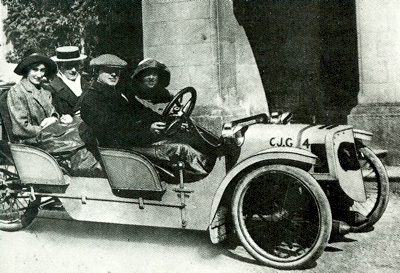 1912 Morgan experimental four-seat 3-wheel built by Harry Morgan.
1912 Morgan experimental four-seat 3-wheel built by Harry Morgan.
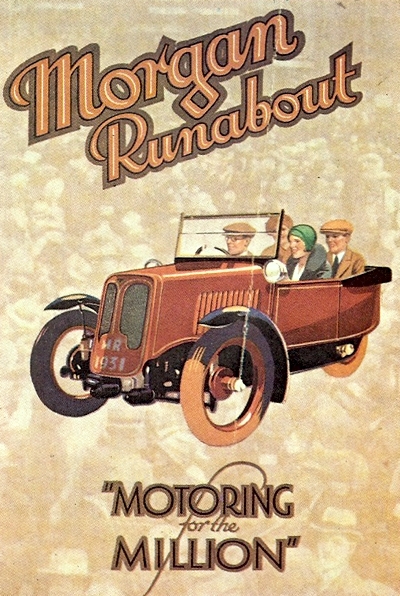 Morgan Runabout Publicity Poster.
Morgan Runabout Publicity Poster.
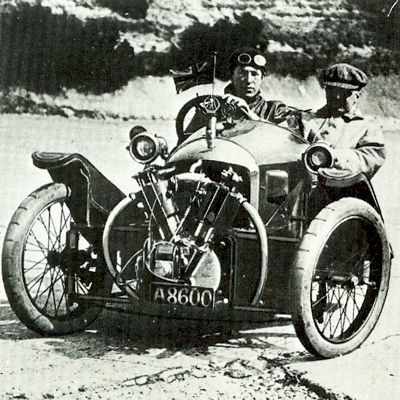 1913 Morgan GP Model, powered by a twin-cylinder JAP engine.
1913 Morgan GP Model, powered by a twin-cylinder JAP engine.
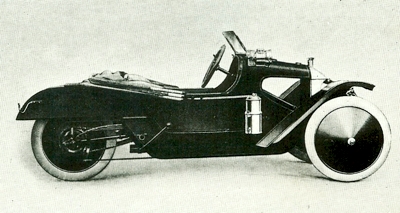 1917 Morgan GP.
1917 Morgan GP.
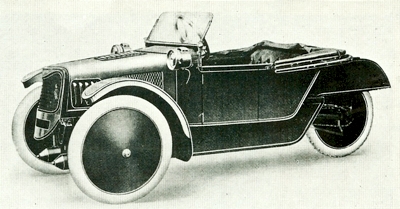 1919 Morgan De Luxe.
1919 Morgan De Luxe.
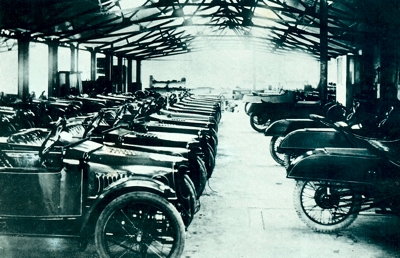 Photo of the Morgan Factory at Pickersleigh Road, Lamvern Link, taken during the 1920's. Morgan's were entirely hand built - a tradition that has continued.
Photo of the Morgan Factory at Pickersleigh Road, Lamvern Link, taken during the 1920's. Morgan's were entirely hand built - a tradition that has continued.
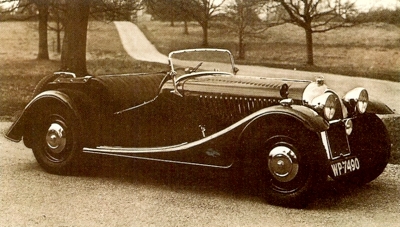 1939 Morgan 4/4, which was fitted with a water cooled 1122cc 4 cylinder engine.
1939 Morgan 4/4, which was fitted with a water cooled 1122cc 4 cylinder engine.
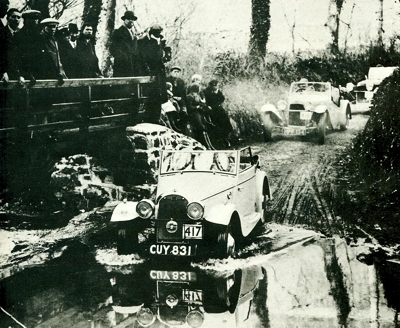 Morgan 4/4 negotiating waterspalsh at the bottom of Darracott hill, Cornwall, during 1939.
Morgan 4/4 negotiating waterspalsh at the bottom of Darracott hill, Cornwall, during 1939.
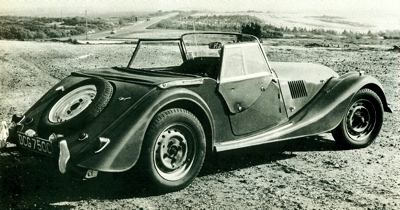 1965 Morgan 4/4 Series II.
1965 Morgan 4/4 Series II.
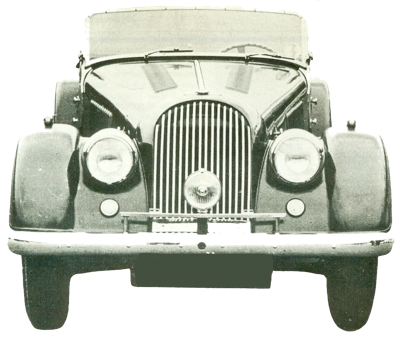 1968 Morgan Plus 4.
1968 Morgan Plus 4.
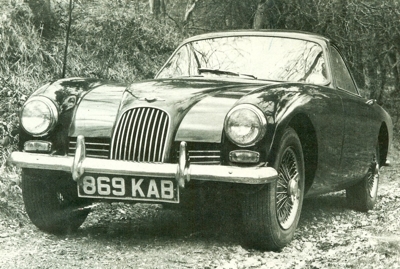 Morgan Plus-Four-Plus - one of only 50 made. It used a fiberglass body, but strangely was not held in high regard at the time by traditional Morgan enthusiasts. Of course - exceptionally collectable today.
Morgan Plus-Four-Plus - one of only 50 made. It used a fiberglass body, but strangely was not held in high regard at the time by traditional Morgan enthusiasts. Of course - exceptionally collectable today.
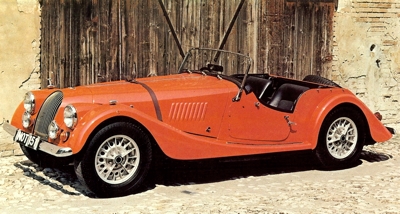 Morgan Plus-8.
Morgan Plus-8. |
And so, this was the original Morgan three-wheeler. It was a single-seater, devoid of bodywork, and it emerged from the Morgan works in 1909. Morgan displayed his devotion to steel tubing by using the side members of the chassis as silencers for the air-cooled engine. It must be remembered that in those days there were few comforts and the open single seat of this first Morgan did not deter people. Indeed, Harry Morgan soon knew he was onto a good thing: the power-to-weight ratio of his little vehicle was such that it had a very useful performance, on the hilly terrain round Malvern, leaving behind up the gradients much bigger and more elaborate cars.
Harrod's Becomes a Morgan Agency
With firm support from his father and his wife, Harry Morgan lost little time in becoming a cyclecar manufacturer. He displayed a Morgan at Olympia in 1910, received a very good Press, and Harrod's, the great London store, became one of the first Morgan agencies. By the 1911 Motor Cycle Show the Morgan three-wheeler had blossomed out as a two-seater runabout. This two-seater, the engine of which was under a coal-scuttle-type bonnet, had a hood, a windscreen and wheel steering and met with immediate success. There was a hand starter and the least' expensive of these three-wheelers sold in 1911 for only £65.
Harry Morgan and his wife, Ruth, soon embarked on a programme of regular entries in competition events; backed by his father's financial help and interest, which included defending his son's product in the motor and motor-cycling papers, the Morgan became very popular. At this time the "Light Car and Cyclecar" was giving a cup for the light car or cyclecar which could cover the greatest distance in an hour at the Brooklands track. Harry set out in a narrow single-seater Morgan (in an attempt to better the 1912 holder of the award), watched by his grandfather in his top hat and clerical collar. The Morgan covered 55 miles within the time limit, but was beaten by Wood's friction-driven GWK by a narrow margin, and set off again in November, to cover nearly 60 miles in the hour.
The French Cycle-car Grand Prix
Harry Martin had already won the first cycle-car race to be held at Brooklands in a Morgan-JAP and, from that time on, the make was to figure in every kind of competition with unqualified success, which helped to sell the cars. In 1913, W. G. McMinnies entered a Morgan for the French Cyclecar Grand Prix and his carefully prepared machine won from a Bedelia and a Violet-Bogey, having averaged just under 42 mph for the 163 miles of the race.
Harry Morgan won a gold medal in the very tough 1913 ACU Six Days' Trial, his Morgan having to run in the side-car class, as three-wheelers had to do on many occasions. Then followed many brilliant performances by Morgans in the great MCC long-distance reliability trials, which still continued to the mid 1970's. All this put the Morgan from Malvern very much in the eye of the buying public and at the 1913 Motor Cycle Show the first of the Grand Prix models made its appearance.
Records at Brooklands and victories in races and trial events caused demand to be more than the small factory could meet and at this time little thought was given to making a full-scale motor car. When World War 1 was over, the Malvern works was very busy. A quickly detachable back wheel was a long-needed improvement and for 1921 the Popular model cost £150. It had an 8 hp JAP engine and the body was made from poplar wood.
The Popular Morgan
By 1923, the price of the aptly-named Popular Morgan was down to £128 (it had been renamed the Standard model, as it happens), and you could decide between a JAP or a Blackburne engine. The fast Grand Prix Morgan attracted the sporting youth who had £155 to spend, but the family man went for the "Family" model which had two very tiny seats behind the front bench, divided by the arch which accommodated the single back wheel. This cost £148 with an air-cooled engine or £158 for the water-cooled model, which had its radiator behind the engine.
The Aero Morgan and MAG Engines
The Aero Morgan made its appearance around the same time, with an Anzani engine and list price of £148. MAG engines were also available, so Harry Morgan had little fear of power unit supplies drying up. He kept the two-speed chain-and-dog transmission, eventually agreed to gear-down the direct steering, and put an extensive list of extras in his catalogues, such as Impirvo puncture-proof fillings in the inner tubes of the tyres for 7/6d and a four-speed gear for £10 extra.
In those days the British roads were comparatively free, and three-wheelers, apart from being economical on petrol, tyres and insurance (not then compulsory), commanded an annual tax of only £4, compared to £8 a year for an Austin Seven - small change these days but not an insignifican sum back then. It was enough to ensure Morgans were in great demand and rivals appeared every so often. None was as well liked in those days as the make from Malvern, where the works had to be expanded to meet the dealers' requirements.
Three Wheelers Banned from Speed Events
In 1923 and again in 1924 Morgan won the top award in the Junior Car Club's General Efficiency Trial. In 1924, there was a set back to Harry Morgan's keen appreciation of competition work as a means of proving and popularising his products ... in the fourth JCC 200-Mile Race at Brooklands E. B. Ware's Morgan-JAP overturned and its occupants were very badly hurt. Thereafter, the authorities banned three-wheelers from speed events. This was a great blow and these machines had to revert to motor-cycle status under the ACU regulations. They were still permitted in trials, however, but it was some years before they were again allowed to take part in car races.
The New Cyclecar Club and Morgan-Blackburne
It took the formation of the New Cyclecar Club to achieve this and it was perhaps poetic justice that in the first NCC event, a race with artificial corners, at Brooklands, it was a four-wheeler and not one of the tricar competitors that overturned. In 1924 Morgans featured electric lighting as a £8 option, and side valve and overhead valve, air-cooled and water-cooled, models were well established, while 75 mph was guaranteed from the single-seater Morgan-Blackburne.
Many more competition victories were achieved before the speed' ban of 1924 came into being, and in that year the 976 cc Popular Morgan sold for £110, the 1098 cc Aero Morgan for £148 and the single-seater for £160. The price of conventional cars was falling, however, and some elaborate three-wheeled rivals to the Morgan had appeared. However, the light Morgans (three-wheelers had to weigh under 8 cwt to qualify for the tax reduction), which could give 45 or more mpg and run easily at 70 mph in 40 bhp form, went on selling. Moreover, they were getting faster and faster in racing guise.
The Harold Beart Blackburne
Harold Beart built himself a very special water-cooled 1096cc Blackburne vee-twin car with a 3.33 to 1 top gear and a streamlined body weighing only 43lb, which put 91.48 miles into the hour on Brooklands (whereas in 1912 Harry Morgan had not exceeded 60) and which was able to exceed 100 mph. In later years the Morgan team in the Light Car Club's relay race at the track were always the most exciting sight of the day and the only real challengers of the works Austin Seven team. They crackled round at the top of the steep bankings, the drivers keeping both hands on the steering wheels by locking the hand throttles open with rubber bands.
Morgans, like motor cycles, relied on Bowden-wire controls and drip-feed lubricators. Dynamo lighting had become standardised by 1925, by which year the Standard model was sold for £95, when an Austin Chummy cost £149. De luxe models made up the range and you could go courting a girl in an Aero if you could afford £130. The following year, 1926, Eric Fernihough, the famous racing motor cyclist, set something of a vogue by installing a single-cylinder engine of 494 cc in a racing Morgan.
Grease-Gun Lubrication
For the 1927 season the bevel box was improved, grease-gun lubrication was introduced and front-wheel brakes were fitted to some of the Morgan range. You could even have an electric starter to turn the vee-twin engine if you paid an additional £10; dashboards were of mottled aluminum and the Standard model was, at the time, considered a bargain at £89 with double-pane windscreen and electric horn. There were plenty of motor-sport successes too - enough to ensure the Morgan Club would be re-formed in 1927.
In the MCC London-Edinburgh Trial alone fourteen Morgan trikes brought home eleven gold medals and three silver medals. Before 1928 there was a further price reduction of four pounds on the Standard two-seater and the first of the Super Sports models made its appearance, priced at £155 with a tuned 10/40 overhead valve JAP high-compression engine. This same engine was fitted at the front of the Aero model, which was then priced at £132, but with an air-cooled JAP twin this spartan and sporting Morgan sold at £119.
The family man Morgan aficionado could purchase a two-by-two Family model for £102, or only £112 for the water-cooled power plant. These were the 1928 prices that enabled Harry Morgan to hold his own, in his little factory, with the prevailing small cars on four wheels, many of them now carrying saloon bodywork. Minor improvements marked the 1929 Morgans, but the design was virtually unchanged from the original 1909 conception.
Clive Jones Makes and C. T. Jay
Geared steering, still of a very high ratio, became standard instead of being offered as an extra, and greater stability was given to some of the more sporting models by using a wide-track front-end. Harry Morgan continued to drive his cars in long and strenuous trials, and the great Morgan exponent Clive Jones made his debut and Malvern had a works driver in the factory store-keeper, C. T. Jay, who won the Cyclecar Grand Prix at Brooklands in 1929 at 64.7mph in a 750cc Morgan-JAP.
Gwenda Stewart and Three Speed Transmissions
By then both the Standard and the Family models were listed at a modest £87 10s, the Aero at £110 and the Super Sports, which was the sophisticated sports version, at £145. Morgans were inexpensive to buy and to run, they were enormous fun, and they could be looked after by anyone who had been used to servicing his own motor bike; nor could Morgans be called slow vehicles. In 1930, at the Paris track, a woman, Gwenda Stewart (later Hawkes), got 113 mph out of her racing version. However, time moves on and the wise and wily Harry Morgan felt the need for some changes in his odd but excellent little cyclecars. So in 1930 the fool-proof two-speed transmission was replaced by a three-speed gearbox at the end of that enclosed propeller shaft, final drive being now by means of a single chain to the rear wheel.
Two-speeders were made up to 1933, but only in small numbers, although this transmission was retgined for the Family model so that it could be sold for as little as £80. The M-type chassis featured a knock-out back wheel spindle and was much lowered. In fact, refinement was the watch-word; even the twin aero screens on the Aero model were replaced with a two-panel Vee screen and the valve gear on the OHV engines was actually enclosed.
It was obvious that the best years of the vintage-type three-wheeler were running out, however: Small cars were becoming more and more efficient, with closed bodywork, four-speed gearboxes and effective brakes. They were also getting less and less expensive, with a number of one-hundred pound examples, culminating in the £100 Ford Popular saloon. Harry Morgan countered this by putting in Ford four-cylinder water-cooled engines, first the Eight and then the Ten, along with his partner George Goodall, in 1935. However, the chain final drive and separate Morgan three-speed gearbox was retained.
The Morgan Matchless Vee-Twin and F-Type
Nor was the two-cylinder engine entirely neglected. The Matchless Vee-twin appeared in the last batch of such Morgans, in air-cooled and water-cooled versions, and with side-by-side and overhead valves. These had a capacity of 990 cc and some of them, the very last of a long line of Morgan three-wheelers, were shipped to Australia after World War 2. However, it is the F-type Ford-powered model that the final range of three-wheelers is best remembered.
There was the handsome Super Sports, with its spare wheel recessed in a barrel-tail, and the Family model, with more space for growing children than the first Morgan to carry this type-name, and with a dummy radiator-grill, adopted in 1933. Although the Morgan works at Pickersleigh Road, Malvern Link were about the smallest car-manufactury in the United Kingdom at the time, the company knew what was needed to keep open.
The Morgan 4/4
The unavoidable demise of the three-wheeler in pre-war times was countered at Malvern by the introduction of a very sporting four-wheeler in 1935. It was a low-hung, compact, and distinctly good-looking little car, making good use of the three-wheeler Morgan's independent front suspension and separate gearbox, but having a conventional back axle. It was in some ways a rival of the MG Midget from Abingdon and was the salvation of the long-established company, when three-wheeler sales had been flagging not only here in the US, but in their own British market.
For an engine for the new four-wheeler, which was called the Morgan 4/4, a 1122 cc Coventry Climax was used, giving 34bhp at 4500 rpm. This was an overhead-inlet, side-exhaust-valve engine, which enabled the little car to do 70 mph. The new 4/4 cost 185 gns in 1936 and was to become very popular and also to carry on the great Morgan competition reputation. The chassis was very low, being underslung beneath the back axle; the original 4/4s were two-seaters, but in 1937 a four-seater was added, which in no way departed from the car's sporting flavour.
Although the famous three-wheelers did not fade out until war intervened, the Morgan 4/4 was growing more popular and a neat drophead coupe was announced in 1938, costing £236. When supplies of the Coventry Climax engine dried up, a Standard Ten specially modified for the Morgan Motor Company was substituted. This was of 1267 cc and developed a useful 39 bhp at 4800 rpm. These 4/4s gained awards in the RAC Rally and one ran in the Le Mans 24-hour race in 1938, entered by a Miss Fawcett.
This latter event led to the introduction of a Le Mans Replica model, with fold-flat windscreen, cycle-type front mudguards, a slightly smaller engine swept volume to put the car in the 1100 cc class, and one instead of the Morgan's traditional twin rear-mounted spare wheels. It cost £250 and could exceed So mph, Morgan never departed from the sports-car image so well exemplified by the 4/4. After the war a change to the z-liter Standard Vanguard engine put it into a larger and more exciting category, the chassis merely being strengthened and enlarged to make this possible.
The new model was called the Plus-Four and cost originally £625 as a two-seater and £723 as a coupe. Increased performance was then gained by installing the Triumph TR2 and TR3 power units, in 1954 and 1956 respectively; Morgan re-entered the smaller sports-car field with the Series 11 4/4 with side-valve Ford Ten engine, brought out at the 1955 Motor Show. These cars maintained the great competition background of the make and along with a Plus-Four-Plus glass-fibre coupe, led to the 1977 Morgan models: the 3.1--liter Plus Eight, which was using the light-alloy Rover V8 engine and gearbox, and the OHV Ford-powered 1600 4/4s.
For a long time exposed headlamps and a non-adjustable driving-seat, along with wooden floorboards, were a Morgan hallmark. Recessed headlamps were eventually adopted and the Rover power unit sounded the death-knell of the separate gearbox. Otherwise the Morgan was largely unchanged, in specification, in hand construction under the control of old-style craftsmen, and in its purely sporting demeanour. The Plus-8 had a very high performance in respect of top pace and pick-up, and the sporting successes have continued, including a class win at Le Mans in 1962.
The Plus 8
From 1968 the 4/4 was somewhat overshadowed by the release of the Plus 8. This latter model was released after Triumph discontinued the manufacture of the TR4 engine, Morgan this time opting to utilize the silky smooth Rover 3528cc light-weight V8. Accommodating this larger engine necessitated the wheelbase be lengthened by ten inches, while the body was widened to allow more under-bonnet space. At first the Plus 8 retained the separate Moss gearbox, but from the spring of 1972 this was dropped, and the cars were built with the Rover 3500S type of four speed all-synchro gearbox in unit with the 151bhp engine.
From the beginning of 1977 this box was in-turn replaced by the new five-speed transmission as fitted to the big Rover 3500 hatchback, and at the same time the latest 155bhp engine was fitted. In that form, the Plus 8 was a very fast car indeed, with a top speed of 123mph, and very rapid 0-60mph acceleration capability of around 6.5 seconds. The 4/4 was to again emerge from the beginning of 1982, when the old 'Kent' engine was dropped, and a choice of engines was offered – the purchaser could choose from a 1.6-liter single-overhead-cam Escort XR3 engine or a 1.6 liter twin-overhead-cam Fiat twin-cam model, each featuring their own appropriate integral gearboxes, and for 1985 there was also the possibility of a 2.0 1itre Fiat twin-cam also being fitted. The Plus 8 however remained the favorite of Australians, with the car continuing to evolve, not the least of which was the introduction of rack-and-pinion steering. Like the Trabant, there has always been a long waiting list for Morgan’s, however in the case of the latter marque this has been for all the right reasons.
Morgan Aero 8
In 2000, the Morgan Aero 8 was introduced and, as always, the wooden body substructure was ash. (Contrary to popular myth, however, the chassis is metal; aluminum for the Aero 8). The Aero 8, with a BMW V8 engine in a car weighing less than a BMW Z4 and considerably less than a BMW M3, (though more than traditional Morgans) is even faster than the Plus 8, delivering what Autoweek magazine termed supercar performance.
The newest Aero 8 (Series IV) puts out 367 hp (274 kW) at 6100 rpm giving it a top speed of over 170 mph (270 km/h). Due to the Aero 8's light weight it can do 0–62 mph (100 km/h) in 4.5 seconds. During its customer production lifetime (2002–2009), the Aero was configured in five official versions, (I,II, III, IV and the Aero America) with variations in styling, engines, transmissions, braking and suspension. The Company canceled its production in 2009. It was followed by the Aeromax, a limited coupe edition of 100 units produced between 2008 and early 2010. The year of highest production was 2002.
Harry Morgan's father died in 1937, but Harry survived until 1959, dying at the age of 77, his cyclecar ambitions amply fulfilled. His son, Peter Morgan had joined the company in 1947 and was running it in 1975, very much as his father did before him.
Also see: Morgan History (AUS Site) 